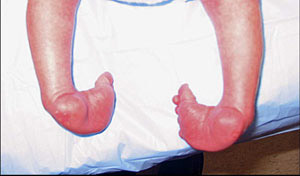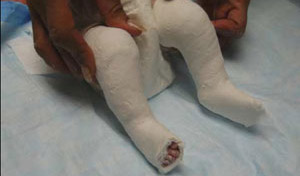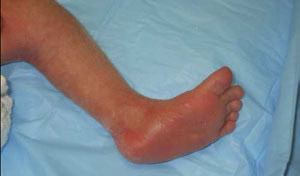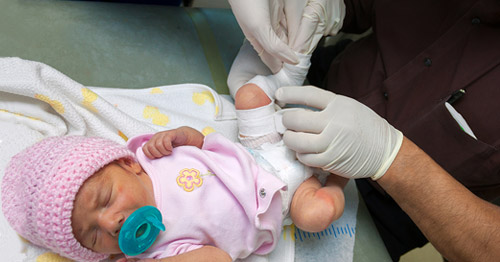Clubfoot
Immediately apparent at birth, clubfoot is a condition in which the foot – or sometimes both feet – are turned inward and are pointing down. In the majority of cases, clubfoot can be successfully treated without surgery, using the Ponseti method.
What is clubfoot?
Clubfoot, known as congenital talipes equinovarus by medical professionals, is a treatable birth defect that affects the lower legs, feet and ankles of newborns, with a noticeable inward curve of the toes, heel and medial (inner) arch. Clubfoot occurs in varying degrees of severity and may be treated by stretching and casting. In rare cases, surgery is necessary.
How common is clubfoot?
Approximately one in every 1,000 newborns has clubfoot, and two thirds of these cases affect boys. It occurs in both feet in about 50% of all cases. The incidence is more likely if there is a history of the defect within the family.
What causes clubfoot?
The exact causes of clubfoot are unknown. It is known that a mutation in the PITX1 gene, which helps construct a protein essential for lower limb development, is associated with clubfoot. Risk factors include family history, parental tobacco use, maternal obesity, male sex, and early amniocentesis (before 15 weeks of gestation).
Is clubfoot genetic?
Genetics play a role in club foot. The work of Ruth Wynne-Davies demonstrated that the occurrence rate of clubfoot was 17 times higher for first degree relatives and six times higher in second degree relatives. We also know that there is a mutation in the PITX1 gene on chromosome five which impacts lower limb development.
What are the different types of clubfoot?
Congenital clubfoot, meaning that the condition exists at birth and/or during gestation, may be idiopathic (of unknown cause) or non-idiopathic, including as an acquired case resulting from a separate injury or condition, such as an infection or neurological problem.
- Idiopathic: Most cases (80%) of clubfoot are idiopathic, meaning the cause is unknown. Usually, idiopathic clubfoot occurs in isolation and is the patient’s only skeletal abnormality.
- Non-idiopathic: Though rarer, this type of clubfoot may be a characteristic of a genetic syndrome or neurological disorder which may affect other parts of the body.
- Complex: A complex clubfoot tends to be a non-idiopathic type, however, may be the result from improper treatment of an idiopathic clubfoot. It is generally stiffer and more of a challenge to treat.
- Acquired: Lastly, a clubfoot deformity may occur in an individual with compromised nerve connections or irregular blood vessels in the muscles in the lower extremity due to an injury or illness (such as meningitis, polio). This leads to an imbalance of muscle forces which result in a clubfoot deformity.
What are the symptoms of clubfoot?
A clubfoot is misshapen to the extent that the sole of the foot points inward and upward toward the groin, rather than down toward the floor. Often, there are deep skin creases in the sole and heel. There is a significant instep/arch, moderate to severe intoeing of the forefoot, and a tight Achilles tendon that causes the heel to turn inward. The joints of the ankle and foot are stiff. The big toe may be short, and the top of the foot can be quite plump and stubby. Sometimes there is no palpable pulse on the top of the foot because the artery which supplies that region is insufficient. Additionally, the calf may be thinner than normal, with tighter, contracted muscles.
How is clubfoot diagnosed?
In many instances, clubfoot is diagnosed in utero during the fetus’s 20-week anatomic ultrasound. Otherwise, it is identified at birth due to its shape and abnormal movement. X-rays of the foot are rarely needed to make a diagnosis, but they are helpful when distinguishing a mild clubfoot from another neonatal foot deformity, such as metatarsus adductus, which can also result in an inward turn of the foot.
What is the treatment for clubfoot?
The predominant treatment for clubfoot is a system of weekly cast applications during the first weeks of the child’s life. This treatment, known as the Ponseti method or technique, uses a series of casts to gradually realign the tendons, ligaments, joint capsules, and certain bones in a newborn child's foot. Most infants will require a minimally invasive surgery to lengthen their Achilles tendon before the final cast is applied.

Clubfoot with marked curvature of the foot, called cavus deformity, before treatment.

First stage of Ponseti casting treatment.

After the first cast, the foot is straight and the cavus and crease are no longer evident.
What type of doctor treats clubfoot?
Pediatric orthopedic surgeons and pediatricians with specialized training in the Ponseti technique generally treat babies and children with clubfoot.
Will clubfoot get better without treatment?
It is essential to initiate cast treatment using the Ponseti method shortly after the diagnosis of clubfoot is established. Patients who start treatment younger need fewer casts, have less chance of relapse, and more favorable long-term outcomes. Most babies require four to eight toe-to-groin plaster casts that are changed weekly. After the last cast, a full-time brace must be worn for three months and then for sleep until five years old.
Can clubfoot cause problems later in life?
While the deformity can persist into adulthood and impair a person’s gait and quality of life, children who are diagnosed and treated early are expected to lead normal lives and have an ability to walk and run just like their peers.
Can kids with clubfoot play sports?
Yes, after treatment for club foot, children can play sports. Most are unrestricted and may participate in any vigorous, high impact activity. Some professional and Olympic athletes have had clubfoot.
Reviewed and updated by
David M. Scher, MD
;
John S. Blanco, MD
;
Emily R. Dodwell, MD, MPH, FRCSC
;
References
- Scher DM. The Ponseti method for treatment of congenital club foot. Curr Opin Pediatr. 2006 Feb;18(1):22-5. doi: 10.1097/01.mop.0000192520.48411.fa. PMID: 16470157.
- Yau, A. & Doyle, S. (2020). Clubfoot for the primary care physician: frequently asked questions. Current Opinion in Pediatrics, 32 (1), 100-106. doi: 10.1097/MOP.0000000000000860.

